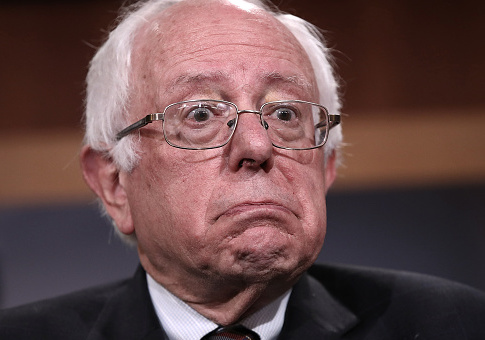The implementation of nationwide, single-payer health care would cost the U.S. government more than $32 trillion over ten years, according to a new report from the libertarian Mercatus Center.
The paper, authored by Mercatus scholar Charles Blahous, assesses the fiscal impact of Sen. Bernie Sanders's (I., Vt.) Medicare for All Act. The proposal, which would see the rollout of Medicare coverage to all Americans regardless of age, was a hallmark of Sanders’s run for the Democratic presidential nomination in 2016.
Under ideal assumptions, Blahous writes, Medicare for All would mean that federal spending on health care would rise to 12.7 percent of GDP by 2031, roughly doubling its current rate. Doubling all current income and corporate tax revenues would be insufficient to finance this massive growth in federal spending, which would itself be more than double all currently projected federal discretionary appropriations.
This enormous price tag is actually marginally less than current projected national health expenditures over the same period of time. The paper finds that under ideal conditions, national health expenditures (NHEs) would be about $90 billion less in 2022 under the Medicare for All plan, thanks in large part to a drop in administrative costs and a slight fall off in personal health spending.
NHEs are a measure of the total spending on health care by all Americans: individuals, companies, cities, states, and the federal government. The decline in NHEs under Medicare for All is a function of a massive cost redistribution. Responsibility would move from individual consumers to the federal government—which would take on an additional $2.5 trillion in annual health care costs, a bill to be footed by the taxpayer—and medical service providers like hospitals, which would almost certainly lose large sums of money under a plan that mandates they accept Medicare's extremely low payment schedule.
That assumption—that Medicare for All would mean all Americans enjoying the much lower prices Medicare commands in buying health care services—is key to the slight advantage the Sanders plan has over the current trajectory. That goes away, the paper finds, if for example we assume that payments will be made at the current average market rate—the mean of all of the private and public health care prices in the market today. If we use that number, then the ten-year cost of Medicare for All rises to $38 trillion, well-outstripping status quo projections.
Other key assumptions—all of which Blahous explicitly outlines—keep the cost of Medicare for All lower than what it would likely actually be. For example, the Sanders plan assumes that the government could successfully substitute all brand-name drugs with generics—failing to do so would make "actual savings… less than assumed under these projections." The estimate of the amount of savings that would accrue from reduced administrative costs is similarly termed "aggressive" by Blahous, and would likely be far less significant if the Medicare-using population quintupled.
In other words: Medicare for All would likely be more expense than the status quo, a cost that would be borne by taxpayers in one way or another, rather than by individual consumers.
"There should be a robust public discussion," Blahous concludes, "of whether these outcomes are desirable and practicable before M4A's enactment is seriously considered."
